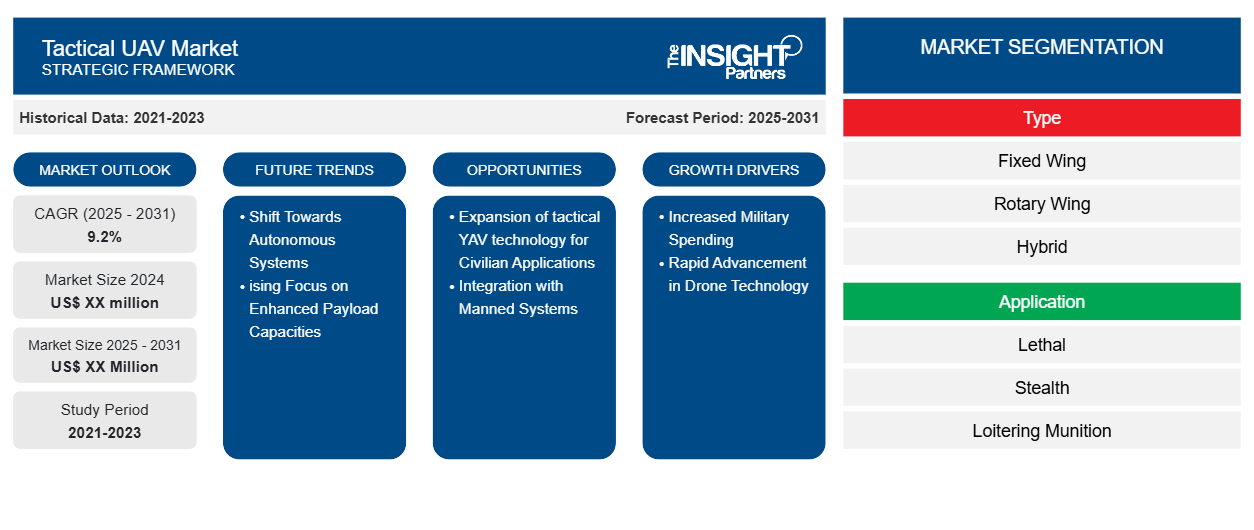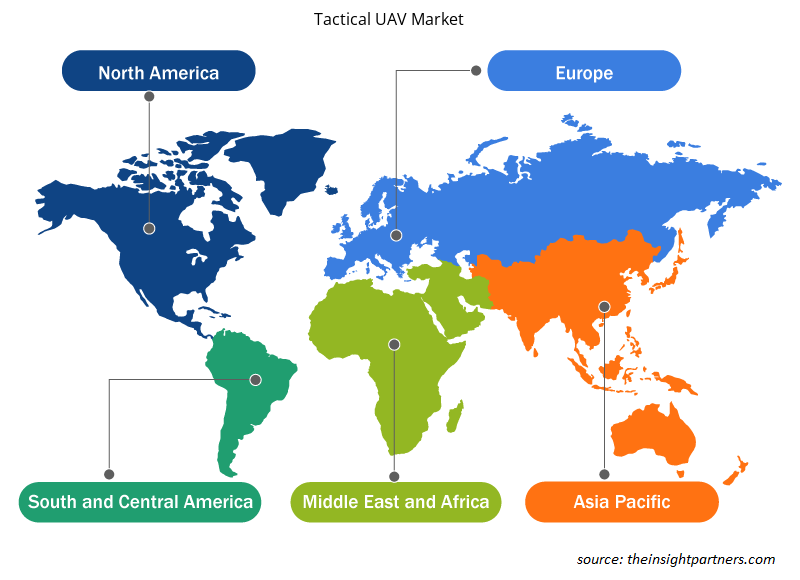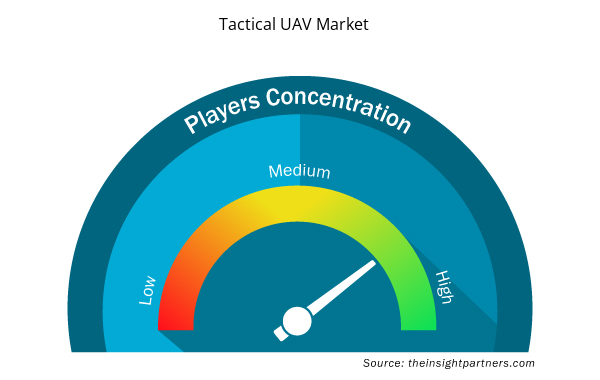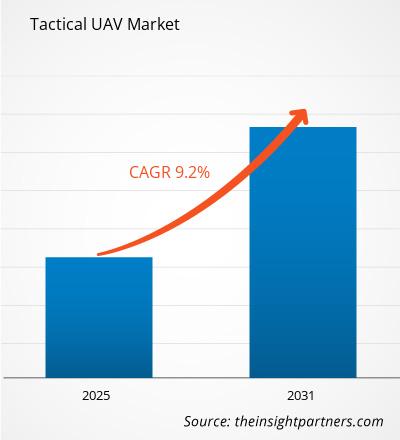The Tactical UAV Market is expected to register a CAGR of 9.2% from 2025 to 2031, with a market size expanding from US$ XX million in 2024 to US$ XX Million by 2031.
The report is segmented by Type (Fixed Wing, Rotary Wing, Hybrid), Application (Lethal, Stealth, Loitering Munition, Target). The global analysis is further broken-down at regional level and major countries. The Report Offers the Value in USD for the above analysis and segments.
Purpose of the Report
The report Tactical UAV Market by The Insight Partners aims to describe the present landscape and future growth, top driving factors, challenges, and opportunities. This will provide insights to various business stakeholders, such as:
- Technology Providers/Manufacturers: To understand the evolving market dynamics and know the potential growth opportunities, enabling them to make informed strategic decisions.
- Investors: To conduct a comprehensive trend analysis regarding the market growth rate, market financial projections, and opportunities that exist across the value chain.
- Regulatory bodies: To regulate policies and police activities in the market with the aim of minimizing abuse, preserving investor trust and confidence, and upholding the integrity and stability of the market.
Tactical UAV Market Segmentation
Type
- Fixed Wing
- Rotary Wing
- Hybrid
Application
- Lethal
- Stealth
- Loitering Munition
- Target
You will get customization on any report - free of charge - including parts of this report, or country-level analysis, Excel Data pack, as well as avail great offers and discounts for start-ups & universities
Tactical UAV Market: Strategic Insights

- Get Top Key Market Trends of this report.This FREE sample will include data analysis, ranging from market trends to estimates and forecasts.
Tactical UAV Market Growth Drivers
- Increased Military Spending: Many countries are significantly increasing their defense budgets, which directly contributes to the growth of the tactical UAV market. This spending is driven by the need for enhanced surveillance, reconnaissance, and combat capabilities in modern warfare. Tactical UAVs provide an efficient means to gather intelligence and conduct operations without risking human lives, making them an attractive investment for military forces. As nations prioritize advanced technologies, the demand for tactical UAVs is expected to rise.
- Rapid Advancement in Drone Technology: The rapid development of drone technology has been a major catalyst for the tactical UAV market. Innovations such as improved sensors, advanced communication systems, and artificial intelligence integration have enhanced the operational capabilities of UAVs. These advancements enable better real-time data analysis, improved flight endurance, and greater operational flexibility. As these technologies continue to evolve, they will likely lead to more sophisticated tactical UAV systems that can perform a wider range of missions effectively.
Tactical UAV Market Future Trends
- Shift Towards Autonomous Systems: A significant trend in the tactical UAV market is the movement towards greater autonomy in UAV operations. With advancements in AI and machine learning, UAVs are being developed with capabilities for autonomous navigation, decision-making, and mission execution. This shift reduces the reliance on human operators, allowing for more efficient and timely responses to dynamic battlefield situations. As autonomous technology matures, it is expected to redefine the operational capabilities of tactical UAVs.
- ising Focus on Enhanced Payload Capacities: Another emerging trend is the enhancement of payload capacities in tactical UAVs. Manufacturers are focusing on developing UAVs that can carry a variety of payloads, including advanced surveillance equipment, weapons systems, and communication devices. This versatility allows tactical UAVs to perform multiple roles, from intelligence gathering to direct engagement in combat. As military forces seek multifunctional systems that can adapt to various missions, the demand for UAVs with increased payload capabilities will likely grow.
Tactical UAV Market Opportunities
- Expansion of tactical YAV technology for Civilian Applications: While primarily used in military contexts, tactical UAV technology is finding increasing applications in civilian sectors such as agriculture, disaster response, and infrastructure inspection. The adaptability of UAVs for various purposes opens new avenues for growth outside traditional defense markets. Companies can explore partnerships with governmental and non-governmental organizations to utilize UAVs for search and rescue missions, environmental monitoring, and surveillance, creating a broader customer base.
- Integration with Manned Systems: The integration of tactical UAVs with manned systems is becoming increasingly prevalent. This trend involves using tactical UAVs to complement conventional aircraft and ground forces, providing enhanced situational awareness and operational synergy. By leveraging real-time data from UAVs, commanders can make more informed decisions and execute missions more effectively. As military strategies evolve towards integrated operations, the collaboration between manned and unmanned systems will significantly shape the tactical UAV market.
Tactical UAV Market Regional Insights
The regional trends and factors influencing the Tactical UAV Market throughout the forecast period have been thoroughly explained by the analysts at Insight Partners. This section also discusses Tactical UAV Market segments and geography across North America, Europe, Asia Pacific, Middle East and Africa, and South and Central America.

- Get the Regional Specific Data for Tactical UAV Market
Tactical UAV Market Report Scope
| Report Attribute | Details |
|---|---|
| Market size in 2024 | US$ XX million |
| Market Size by 2031 | US$ XX Million |
| Global CAGR (2025 - 2031) | 9.2% |
| Historical Data | 2021-2023 |
| Forecast period | 2025-2031 |
| Segments Covered |
By Type
|
| Regions and Countries Covered | North America
|
| Market leaders and key company profiles |
Tactical UAV Market Players Density: Understanding Its Impact on Business Dynamics
The Tactical UAV Market is growing rapidly, driven by increasing end-user demand due to factors such as evolving consumer preferences, technological advancements, and greater awareness of the product's benefits. As demand rises, businesses are expanding their offerings, innovating to meet consumer needs, and capitalizing on emerging trends, which further fuels market growth.
Market players density refers to the distribution of firms or companies operating within a particular market or industry. It indicates how many competitors (market players) are present in a given market space relative to its size or total market value.
Major Companies operating in the Tactical UAV Market are:
- Aeronautics Ltd.
- Safran S.A.
- Boeing
- AeroVironment, Inc.
- Elbit Systems Ltd.
Disclaimer: The companies listed above are not ranked in any particular order.

- Get the Tactical UAV Market top key players overview
Key Selling Points
- Comprehensive Coverage: The report comprehensively covers the analysis of products, services, types, and end users of the Tactical UAV Market, providing a holistic landscape.
- Expert Analysis: The report is compiled based on the in-depth understanding of industry experts and analysts.
- Up-to-date Information: The report assures business relevance due to its coverage of recent information and data trends.
- Customization Options: This report can be customized to cater to specific client requirements and suit the business strategies aptly.
The research report on the Tactical UAV Market can, therefore, help spearhead the trail of decoding and understanding the industry scenario and growth prospects. Although there can be a few valid concerns, the overall benefits of this report tend to outweigh the disadvantages.
- Historical Analysis (2 Years), Base Year, Forecast (7 Years) with CAGR
- PEST and SWOT Analysis
- Market Size Value / Volume - Global, Regional, Country
- Industry and Competitive Landscape
- Excel Dataset


- Thermal Energy Storage Market
- Electronic Data Interchange Market
- Virtual Pipeline Systems Market
- Vertical Farming Crops Market
- Saudi Arabia Drywall Panels Market
- Data Annotation Tools Market
- Vessel Monitoring System Market
- Europe Tortilla Market
- UV Curing System Market
- Fish Protein Hydrolysate Market

Report Coverage
Revenue forecast, Company Analysis, Industry landscape, Growth factors, and Trends

Segment Covered
This text is related
to segments covered.

Regional Scope
North America, Europe, Asia Pacific, Middle East & Africa, South & Central America

Country Scope
This text is related
to country scope.
Frequently Asked Questions
What are the options available for the customization of this report?
Some of the customization options available based on request are additional 3-5 company profiles and country-specific analysis of 3-5 countries of your choice. Customizations are to be requested/discussed before making final order confirmation, as our team would review the same and check the feasibility.
What are the deliverable formats of the tactical UAV market report?
The report can be delivered in PDF/PPT format; we can also share excel dataset based on the request.
What are the driving factors impacting the tactical UAV market?
The major factors driving the tactical UAV market are:
1. Rising Military Budget of Different Nations
2. Increasing Deployment of Combat UAVs
What are the future trends of the tactical drones market?
Some of the major trends driving the tactical UAV market are:
1. Emerging Demand from Homeland Security Applications
2. Price Reduction of Drone Components
What is the expected CAGR of the Tactical UAV Market?
The Tactical UAV Market is estimated to witness a CAGR of 9.2% from 2023 to 2031
Trends and growth analysis reports related to Aerospace and Defense : READ MORE..
1.Aeronautics Ltd.
2.Safran S.A.
3.Boeing
4.AeroVironment, Inc.
5.Elbit Systems Ltd.
6.BlueBird Aero Systems Ltd.
7.Baykar
8.General Atomics
9.Leonardo S.p.A.
10.Northrop Grumman Corporation

 Get Free Sample For
Get Free Sample For